Plastic Waste Management Practices in Zanzibar’s Coastal Tourist Communities
Abstract
1. Introduction
2. Materials and Methods
2.1. Study Design
2.2. Description of the Study Area
2.3. Data Collection Methods
2.3.1. Direct Observations
2.3.2. Structured Interviews
2.3.3. Participatory Workshops
2.4. Sampling Strategy
2.5. Data Analysis
3. Results
3.1. Participants Profile by Age Group and Gender
3.2. Types of Plastic Waste in Local Communities
3.3. Waste Collection and Transportation Systems in the Study Area
3.4. Waste Recovery, Reuse, and Treatment Practices
3.5. Community Participation Across Locations and Age Groups
3.6. Disposal and Final Treatment Methods
3.7. Challenges and Opportunities in Managing Plastic Waste in the Study Area; Insight from Participatory Workshop
3.8. Insights from Participatory Workshops
3.8.1. Establishment of Training Programs for the Waste Management Workforce
3.8.2. Enhancement of Public Awareness Campaigns
3.8.3. Investment in Local Technologies
3.8.4. Promotion of Eco-Friendly Packaging Solutions
3.8.5. Implementation of Low-Cost Waste Sorting Machines
3.8.6. Development of Mobile Messaging Platforms or Apps
- Proposed Hybrid Waste Bank Model
- Strategies to Enhance Waste Bank Programs
- 1.
- Community Engagement & Education
- Conduct awareness campaigns in schools, local markets, and cultural/religious gathering spaces to teach the importance of waste segregation and recycling.
- Organize household-level sorting workshops to equip individuals with practical waste management skills.
- Responsible: Waste bank coordinators, local leaders through sheha committees, and volunteers.
- 2.
- Youth and School Involvement
- Responsible: Teachers, school eco-club leaders, student volunteers.
- 3.
- Environmental Clean-ups
- Responsible: Community volunteers, youth groups, NGOs, local authorities, hoteliers.
- 4.
- Practical Recycling & Up-cycling
- Implement small-scale plastic shredding and baling for easier sale to recyclers.
- Responsible: Waste bank administrators, local artisans, technical trainers.
- 5.
- Youth-Led Waste-to-Wealth Initiatives
- Responsible: Youth entrepreneurs, NGOs.
4. Discussion
4.1. Community Participation and Socioeconomic Drivers
4.2. Gender Equity in Waste Management
4.3. Material-Specific Challenges: PET and HDPE
4.4. Private Sector and Multi-Sector Partnerships
4.5. Tourism as a Driver of Plastic Pollution
4.6. Linking Local Insights to Global Frameworks
4.7. Synthesis and Implications
5. Conclusions
6. Theoretical and Practical Implications
6.1. Limitations & Delimitation
6.2. Future Research Directions
Author Contributions
Funding
Institutional Review Board Statement
Informed Consent Statement
Data Availability Statement
Acknowledgments
Conflicts of Interest
Appendix A
| 1. Capital Investment (Initial Costs) | |||||||
|---|---|---|---|---|---|---|---|
| Item | Estimated Cost (USD) | ||||||
| Collection Points | 1200 | ||||||
| Sorting Area Setup | 2000 | ||||||
| Digital/Manual Logbook | 500 | ||||||
| Protective Equipment | 300 | ||||||
| Transportation | 3500 | ||||||
| Total Initial Cost | 7500 | ||||||
| 2. Operating Costs (Annual) | |||||||
| Item | Annual Cost (USD) | ||||||
| Staff Wages | 4800 | ||||||
| Fuel & Transport Maintenance | 2000 | ||||||
| Utilities | 600 | ||||||
| Supplies & Consumables | 400 | ||||||
| Communication | 300 | ||||||
| Marketing & Awareness | 500 | ||||||
| Total Annual Operating Cost | 8600 | ||||||
| 3. Potential Funding Sources | |||||||
| |||||||
| 4. Revenue Streams | |||||||
| |||||||
| 5. Revenue Projection (Year 1–3) | |||||||
| Assuming each household sells 2 kg per day | |||||||
| Year | Households | Waste Collected (kg/year) | Sale of Recyclables (USD) | Membership Fees (USD) | Other Income (USD) | Total Revenue (USD) | |
| 1 | 300 | 219,000 | 6800 | 3600 | 500 | 10,900 | |
| 2 | 400 | 292,000 | 9100 | 4800 | 1000 | 14,900 | |
| 3 | 500 | 365,000 | 11,300 | 6000 | 1500 | 18,800 | |
| 6. Break-even Analysis | |||||||
| Annual operating cost: USD 8600 | |||||||
| Year 1 revenue: USD 10,900 | |||||||
| Break-even achieved in Year 1 if prices & participation are stable. | |||||||
| The price ranges used in this analysis were obtained from [40,41] | |||||||
References
- Faber, B.; Gaubert, C. Tourism and economic development: Evidence from Mexico’s coastline. Am. Econ. Rev. 2019, 109, 2245–2293. [Google Scholar] [CrossRef]
- World Travel & Tourism Council. Travel & Tourism Global Economic Impact & Trends; WTTC: London, UK, 2023; Available online: https://wttc.org/Research/Economic-Impact (accessed on 8 May 2024).
- International Monetary Fund. World Economic Outlook Update, July 2024: The Global Economy in a Sticky Spot; IMF: Washington, DC, USA, 2024; Available online: https://www.imf.org/en/Publications/WEO (accessed on 3 June 2025).
- Santos, R.A.; Méxas, M.P.; Meiriño, M.J.; Sampaio, M.C.; Costa, H.G. Criteria for assessing a sustainable hotel business. J. Clean. Prod. 2020, 277, 121347. [Google Scholar] [CrossRef]
- Wu, J.; Wang, S.; Liu, Y.; Xie, X.; Wang, S.; Lv, L.; Luo, H. Measurement of tourism-related CO2 emission and the factors influencing low-carbon behavior of tourists: Evidence from protected areas in China. Int. J. Environ. Res. Public Health 2023, 20, 1277. [Google Scholar] [CrossRef]
- Abubakar, I.R.; Maniruzzaman, K.M.; Dano, U.L.; AlShihri, F.S.; AlShammari, M.S.; Ahmed, S.M.S.; Al-Gehlani, W.A.G. Environmental sustainability impacts of solid waste management practices in the Global South. Int. J. Environ. Res. Public Health 2022, 19, 12717. [Google Scholar] [CrossRef] [PubMed]
- Hira, A.; Pacini, H.; Attafuah-Wadee, K.; Vivas-Eugui, D.; Saltzberg, M.; Yeoh, T.N. Plastic waste mitigation strategies: A review of lessons from developing countries. J. Dev. Soc. 2022, 38, 336–359. [Google Scholar] [CrossRef]
- Debrah, J.; Teye, G.; Dinis, M. Barriers and challenges to waste management hindering the circular economy in Sub-Saharan Africa. Urban Sci. 2022, 6, 57. [Google Scholar] [CrossRef]
- Ferronato, N.; Maalouf, J. A review of plastic waste circular actions in seven developing countries to achieve sustainable development goals. Waste Manag. Res. 2023; online ahead of print. [Google Scholar] [CrossRef]
- United Nations Economic Commission for Africa. Zanzibar Tourism Satellite Account: Estimating the Contribution of Tourism to the Economy of Zanzibar; UN ECA: Addis Ababa, Ethiopia, 2022; Available online: https://hdl.handle.net/10855/47591 (accessed on 18 May 2024).
- UNICEF. Impact of Tourism on Communities and Children in Zanzibar; UNICEF: Dar es Salaam, Tanzania, 2019; Available online: https://www.unicef.org/tanzania/media/2196/file/Impact%20of%20Tourism%20on%20Children%20and%20Communities%20in%20Zanzibar.pdf (accessed on 28 July 2023).
- World Bank. Zanzibar: A Pathway to Tourism for All: Integrated Strategic Action Plan; World Bank: Washington, DC, USA, 2019; pp. 1–58. Available online: http://documents.worldbank.org/curated/en/9937015652505/77192Zanzibar-A-Pathway-to-Tourism-for-All-Integrated-Strategic-Action-Plan (accessed on 9 September 2024).
- Tan, S.; Li, W.; Liu, X.; Wang, Y.; Wang, M. Exploring paths underpinning the implementation of municipal waste sorting: Evidence from China. Environ. Impact Assess. Rev. 2024, 106, 107510. [Google Scholar] [CrossRef]
- Doukali, I. Enhancing Circular Economy and Waste Management in Zanzibar by Leveraging Young Entrepreneurship and Innovation. Master’s Thesis, Linnaeus University, Växjö, Sweden, 2023. Available online: https://www.diva-portal.org/smash/get/diva2:1769359/fulltext01.pdf (accessed on 17 April 2025).
- European Commission. Horizon Projects Supporting the Zero Pollution Action; Mission Soil Platform: Brussels, Belgium, 2023; Available online: https://mission-soil-platform.ec.europa.eu/sites/default/files/2023-08/horizon%20projects%20supporting%20the%20zero%20pollution%20action-KI0622125ENN.pdf (accessed on 12 October 2024).
- Down to Earth. In hope of a plastic waste-free island. Down To Earth. 2018. Available online: https://www.downtoearth.org.in/waste (accessed on 15 October 2024).
- Dauvergne, P.; Poole Lehnhoff, K. The power of biojustice environmentalism in the Global South: Insights from the politics of reducing single-use plastics in Guatemala. J. Environ. Plan. Manag. 2024, 1–21. [Google Scholar] [CrossRef]
- Kibria, N.I.; Masuk, M.; Safayet, R. Plastic waste: Challenges and opportunities to mitigate pollution and effective management. Int. J. Environ. Res. 2023, 17, 20. [Google Scholar] [CrossRef]
- Boyle, D. Community engagement in waste management and recycling: Best practices and success stories [Short communication]. J. Environ. Waste Manag. Recycl. 2023, 6, 128. Available online: https://www.alliedacademies.org/articles/community-engagement-in-the-waste-management-and-recycling-best-practices-and-success-stories-26057.html (accessed on 6 November 2024).
- Oppong, C.; Mathibe, M.S. Women’s role in promoting sustainable development through stakeholder engagement and environmental policy: African perspectives on the circular economy. Bus. Strat. Dev. 2024, 7, e70051. [Google Scholar] [CrossRef]
- Maione, C. Quantifying plastics waste accumulations on coastal tourism sites in Zanzibar, Tanzania. Mar. Pollut. Bull. 2021, 168, 112418. [Google Scholar] [CrossRef] [PubMed]
- Jacobsen, L.F.; Pedersen, S.; Thøgersen, J. Drivers of and barriers to consumers’ plastic packaging waste avoidance and recycling—A systematic literature review. Waste Manag. 2022, 141, 63–78. [Google Scholar] [CrossRef] [PubMed]
- Huang, S.; Wang, H.; Ahmad, W.; Ahmad, A.; Vatin, N.I.; Mohamed, A.M.; Deifalla, A.F.; Mehmood, I. Plastic waste management strategies and their environmental aspects: A scientometric analysis and comprehensive review. Int. J. Environ. Res. Public Health 2022, 19, 4556. [Google Scholar] [CrossRef] [PubMed]
- Pandey, M.; Dhiman, A.; Kansal, A.; Subudhi, S.P. Plastic waste management for sustainable environment: Techniques and approaches. Waste Dispos. Sustain. Energy 2023, 5, 205–222. [Google Scholar] [CrossRef]
- Tiwari, R.; Azad, N.; Dutta, D.; Yadav, B.; Kumar, S. A critical review and future perspective of plastic waste recycling. Sci. Total Environ. 2023, 881, 163433. [Google Scholar] [CrossRef]
- Jambeck, J.R.; Geyer, R.; Wilcox, C.; Siegler, T.R.; Perryman, M.; Andrady, A.; Narayan, R.; Law, K.L. Plastic waste inputs from land into the ocean. Science 2015, 347, 768–771. [Google Scholar] [CrossRef]
- Deus, B.C.T.; Costa, T.C.; Altomari, L.N.; Brovini, E.M.; Brito, P.S.D.; Cardoso, S.J. Coastal plastic pollution: A global perspective. Mar. Pollut. Bull. 2024, 203, 116478. [Google Scholar] [CrossRef]
- United Nations (UN). Transforming Our World: The 2030 Agenda for Sustainable Development; UN: New York, NY, USA, 2015; Available online: https://sdgs.un.org/2030agenda (accessed on 13 May 2025).
- United Nations Environment Programme (UNEP); One Planet Network. Global Tourism Plastics Initiative; UNEP: Nairobi, Kenya, 2021; Available online: https://www.oneplanetnetwork.org/sites/default/files/2021-12/GTPI_Report2021_veryfinal.pdf (accessed on 8 November 2024).
- One Planet Network. Global Tourism Plastics Initiative 2023 Report; One Planet Network: Paris, France, 2023; Available online: https://www.oneplanetnetwork.org/programmes/sustainable-tourism (accessed on 14 August 2024).
- Gutberlet, J.; Besen, G.R.; de Morais, L.C. Participatory solid waste governance and the role of social and solidarity economy: Experiences from São Paulo, Brazil. Front. Sustain. Cities 2020, 2, 167–180. [Google Scholar] [CrossRef]
- Valentina, T.R.; Putera, R.E.; Salsabila, L. Collaborative governance in handling the waste crisis: A systematic literature review. Int. J. Sustain. Dev. Plan. 2025, 20, 761–770. [Google Scholar] [CrossRef]
- Abatan, O.S.; Adeboyejo, A.T.; Akindele, A.O. The role of stakeholders and technological innovations in enhancing waste governance and service delivery. Pan Afr. J. Health Environ. Sci. 2025, 4, 106–121. [Google Scholar] [CrossRef]
- Willis, K.; Hardesty, B.D.; Vince, J.; Wilcox, C. Local waste management successfully reduces coastal plastic pollution. One Earth 2022, 5, 666–676. [Google Scholar] [CrossRef]
- Oluwadipe, S.; Purchase, D.; Garelick, H.; McCarthy, S.; Jones, H. Mixed method analysis of household recycling challenges and the development of a sustainable recycling indicator. Waste Manag. 2025, 208, 115170. [Google Scholar] [CrossRef] [PubMed]
- Kozhikkodan Veettil, B.; Hua, N.T.A.; Van, D.D.; Quang, N.X. Coastal and marine plastic pollution in Vietnam: Problems and the way out. Estuar. Coast. Shelf Sci. 2023, 292, 108472. [Google Scholar] [CrossRef]
- Tran, V.C.M.; Le, P.C.; Quyen, H.H. A study on plastic waste generation and disposal habits in riverside and coastal households towards the promotion of reducing plastic leakage into the ocean in Da Nang City, Vietnam. J. Mater. Cycles Waste Manag. 2024, 26, 3034–3046. [Google Scholar] [CrossRef]
- Cusba, J.; Pacheco Vélez, C.; Espinosa, L.; Laude, C.; Fuerst, L.; Madera, P.; Valencia, F.; Ángel, N. Plastic pollution in marine coastal areas: Quantifying leakage and evaluating management responses. Mar. Pollut. Bull. 2025, 222, 118677. [Google Scholar] [CrossRef] [PubMed]
- Arbulú, I.; Rey-Maquieira, J.; Sastre, F. The impact of tourism and seasonality on different types of municipal solid waste (MSW) generation: The case of Ibiza. Heliyon 2024, 10, e33894. [Google Scholar] [CrossRef]
- Bisht, A.; Kumar, H.; Nag, A.; Kumar, V. Managing seasonality and overtourism for sustainable tourism development: Challenges and strategies. Int. J. Res. Rev. 2025, 12, 443–453. [Google Scholar] [CrossRef]
- Dauvergne, P.; Poole Lehnhoff, K. The politics of plastic governance in the Global South: Towards justice-oriented approaches. Glob. Environ. Polit. 2024, 24, 124–137. [Google Scholar] [CrossRef]
- Kubota, R.; Horita, M.; Tasaki, T. Integration of community-based waste bank programs with the municipal solid-waste-management policy in Makassar, Indonesia. J. Mater. Cycles Waste Manag. 2020, 22, 10. [Google Scholar] [CrossRef]
- UNDP. Tanga City Waste Banks Project: Empowering Waste Pickers Through a Circular Economy; United Nations Development Programme: Dar es Salaam, Tanzania, 2023; Available online: https://www.tz.undp.org (accessed on 27 April 2025).
- Makina, A. Wecyclers Waste Collection: Providing Waste Collection Services in Low-Income Communities; Infrahub Africa: Cape Town, South Africa, 2023; Available online: https://www.infrahub.africa/case-studies/wecyclers-waste-collection (accessed on 27 April 2025).
- Condé Nast Traveler. Cairo’s Christian Zabbaleen Community Turns Trash into Treasure. 15 March 2023. Available online: https://www.cntraveler.com/story/cairo-egypt-christian-zabbaleen-community (accessed on 19 June 2025).
- Project Planet ID. From Trash to Treasure: The Rise of Waste Banks in Indonesia. 2023. Available online: https://www.projectplanetid.com/post/from-trash-to-treasure-the-rise-of-waste-banks-in-indonesia (accessed on 8 May 2024).
- SAIS Perspectives. One Man’s Trash Is Another Man’s Treasure: The Success of Thailand’s Waste Bank Initiative. SAIS Perspectives 2020. Available online: https://www.saisperspectives.com/2020-issue/2020/2/10/one-mans-trash-is-another-mans-treasure-the-success-of-thailands-waste-bank-initiative (accessed on 13 June 2024).
- Honeyguide Foundation. Tanzania Waste Directory: Your Trash Friend; Honeyguide Foundation: Arusha, Tanzania; Available online: https://www.honeyguide.org/seminar_downloads/Tanzania%20Waste%20Directory-%20your%20trash%20friend.pdf (accessed on 7 May 2025).
- Climate Chance. Plastic Recycling Project and Youth Empowerment (PREYO); Climate Chance: Bonn, Germany, 2023; Available online: https://climate-chance.org (accessed on 7 July 2024).
- World Bank. Maldives Is Turning Waste to Wealth, Energizing Youth to Safeguard Its Future. 22 July 2022. Available online: https://www.worldbank.org/en/news/feature/2022/07/22/maldives-is-turning-waste-to-wealth-energizing-youth-to-safeguard-its-future (accessed on 18 May 2025).
- Circle Economy. Smart, Scalable Eco-Brick Schools Made Out of Plastic for Côte d’Ivoire; Knowledge Hub: West Chester, PA, USA, 2022; Available online: https://knowledge-hub.circle-economy.com/cec/article/799 (accessed on 3 July 2024).
- Amoah, J.O.; Britwum, A.O.; Essaw, D.W.; Mensah, J. Solid waste management and gender dynamics: Evidence from rural Ghana. Res. Glob. 2023, 6, 100111. [Google Scholar] [CrossRef]
- Global Plastic Action Partnership. Gender Analysis of the Plastics and Plastic Waste Sectors in Ghana: Baseline Analysis Report; Global Plastic Action Partnership: Cologny, Switzerland, 2023. [Google Scholar]
- United Nations Environment Programme (UNEP). Why Gender Dynamics Matter in Waste Management; UNEP: Nairobi, Kenya, 2022; Available online: https://www.unep.org/ietc/news/story/why-gender-dynamics-matter-waste-management (accessed on 9 June 2024).
- Waste Management World. Breaking Gender Barriers in the Circular Economy. 8 March 2024. Available online: https://waste-management-world.com/resource-use/breaking-gender-barriers-in-the-circular-economy/ (accessed on 3 August 2025).
- Wittmer, J. Dirty work in the clean city: An embodied urban political ecology of women informal recyclers’ work in the ‘clean city’. Environ. Plan. E Nat. Space 2023, 6, 1343–1365. [Google Scholar] [CrossRef]
- Sathicq, B.; Sabatino, R.; Di Cesare, A.; Eckert, M.; Fontaneto, D.; Rogora, M.; Corno, G. PET particles raise microbiological concerns for human health while tyre wear micro-plastic particles potentially affect ecosystem services in waters. J. Hazard. Mater. 2022, 429, 128397. [Google Scholar] [CrossRef] [PubMed]
- Matee, N.; Kenyan Startup Founder Nzambi Matee Recycles Plastic to Make Bricks That Are Stronger Than Concrete. World Architecture 12 February. 2021. Available online: https://worldarchitecture.org/architecture-news/egmeg/kenyan-startup-founder-nzambi-matee-recycles-plastic-to-make-bricks-that-are-stronger-than-concrete.html (accessed on 9 July 2024).
- UNICEF. UNICEF Breaks Ground on Africa’s First-of-Its-Kind Recycled Plastic Brick Factory in Côte d’Ivoire. 29 July 2019. Available online: https://www.unicef.org/wca/press-releases/unicef-breaks-ground-africas-first-its-kind-recycled-plastic-brick-factory-c%C3%B4te (accessed on 16 December 2023).
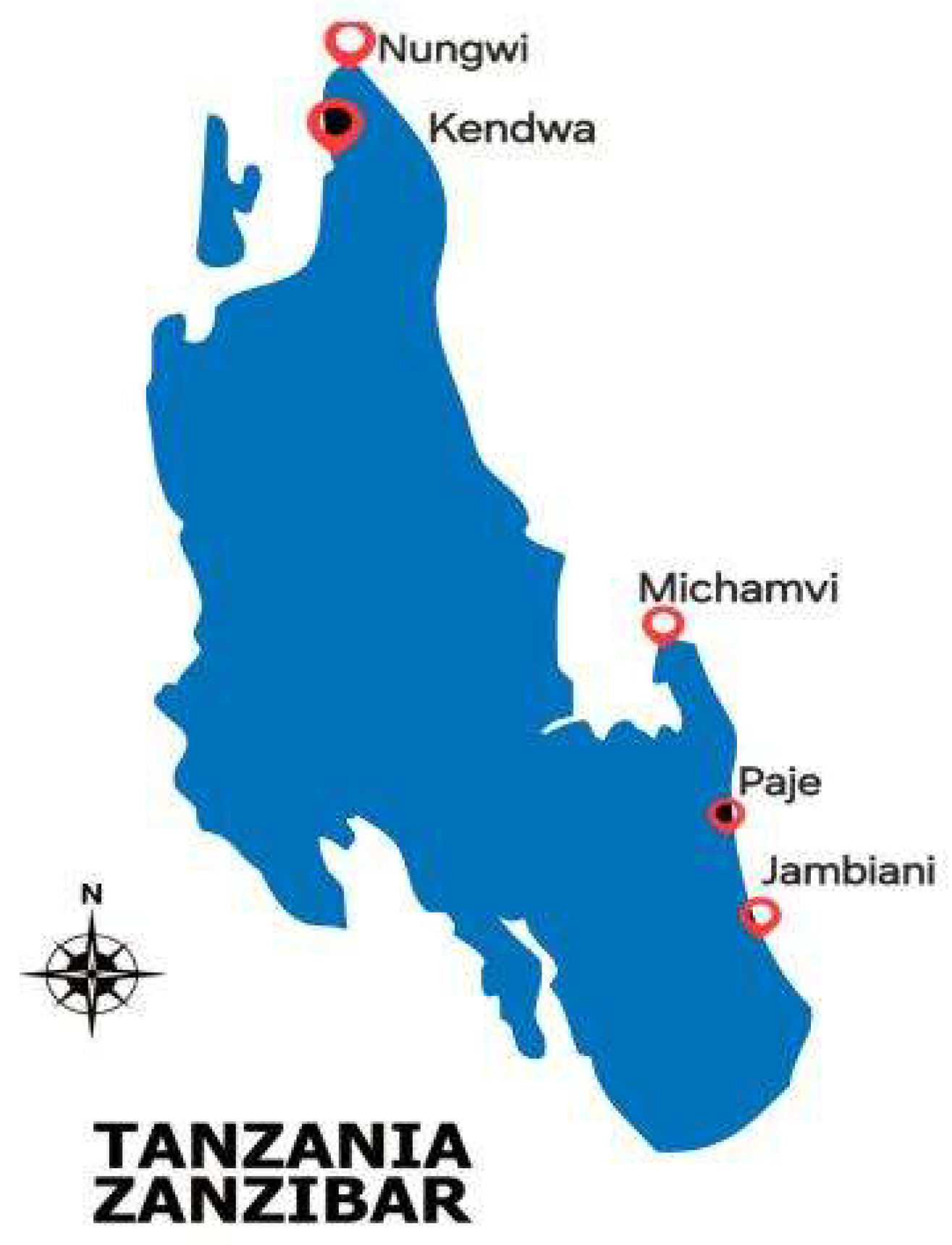

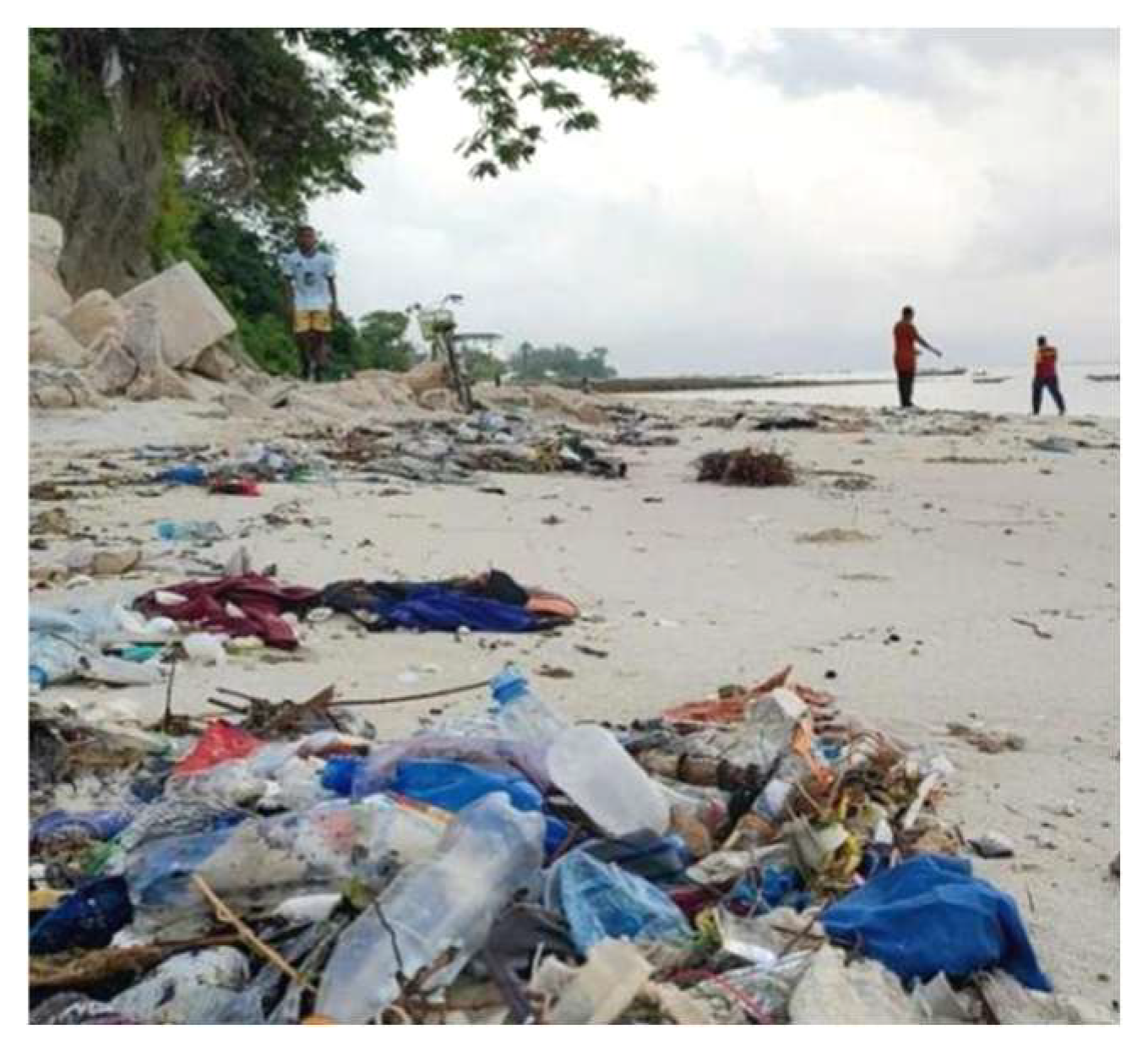
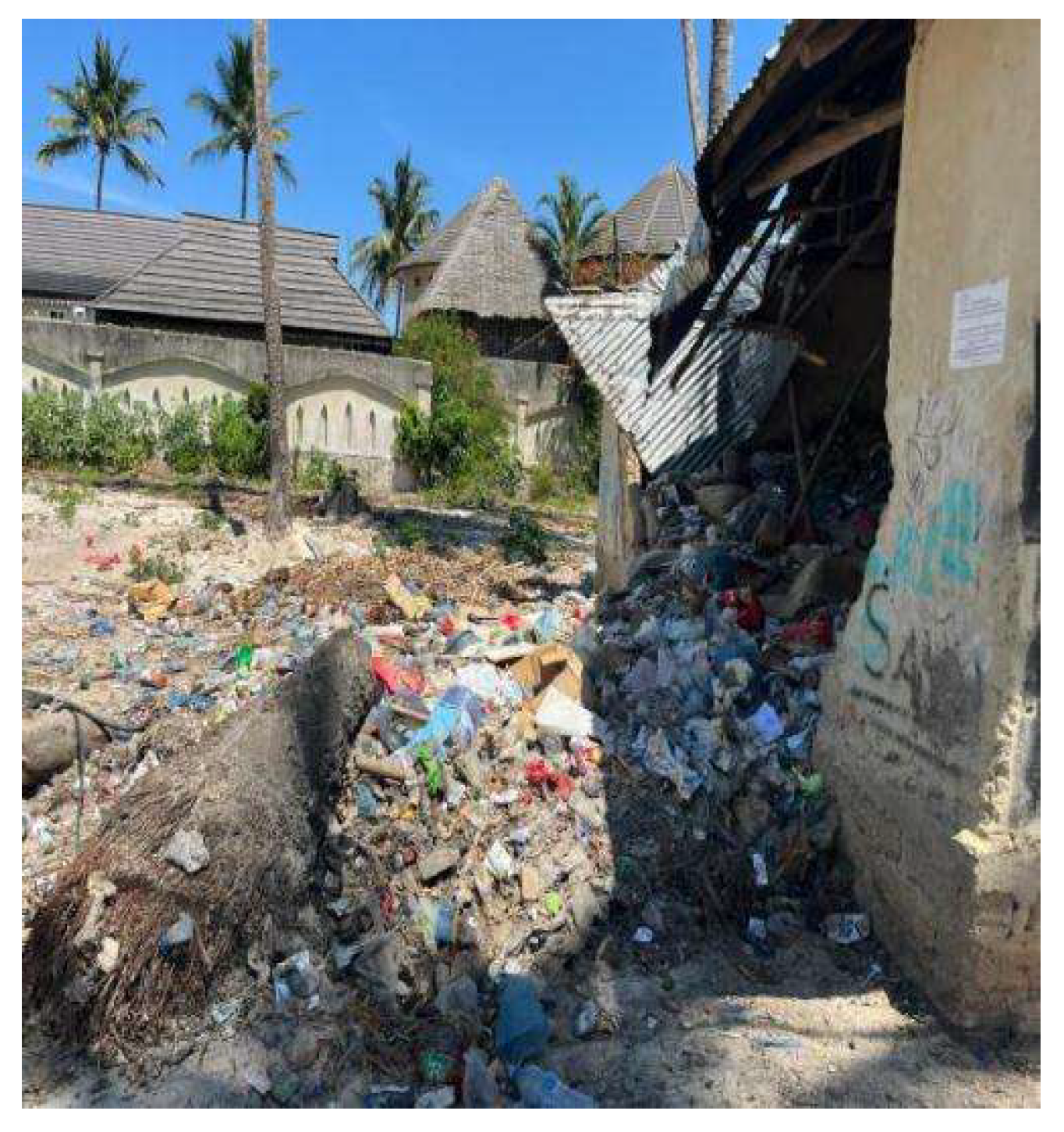

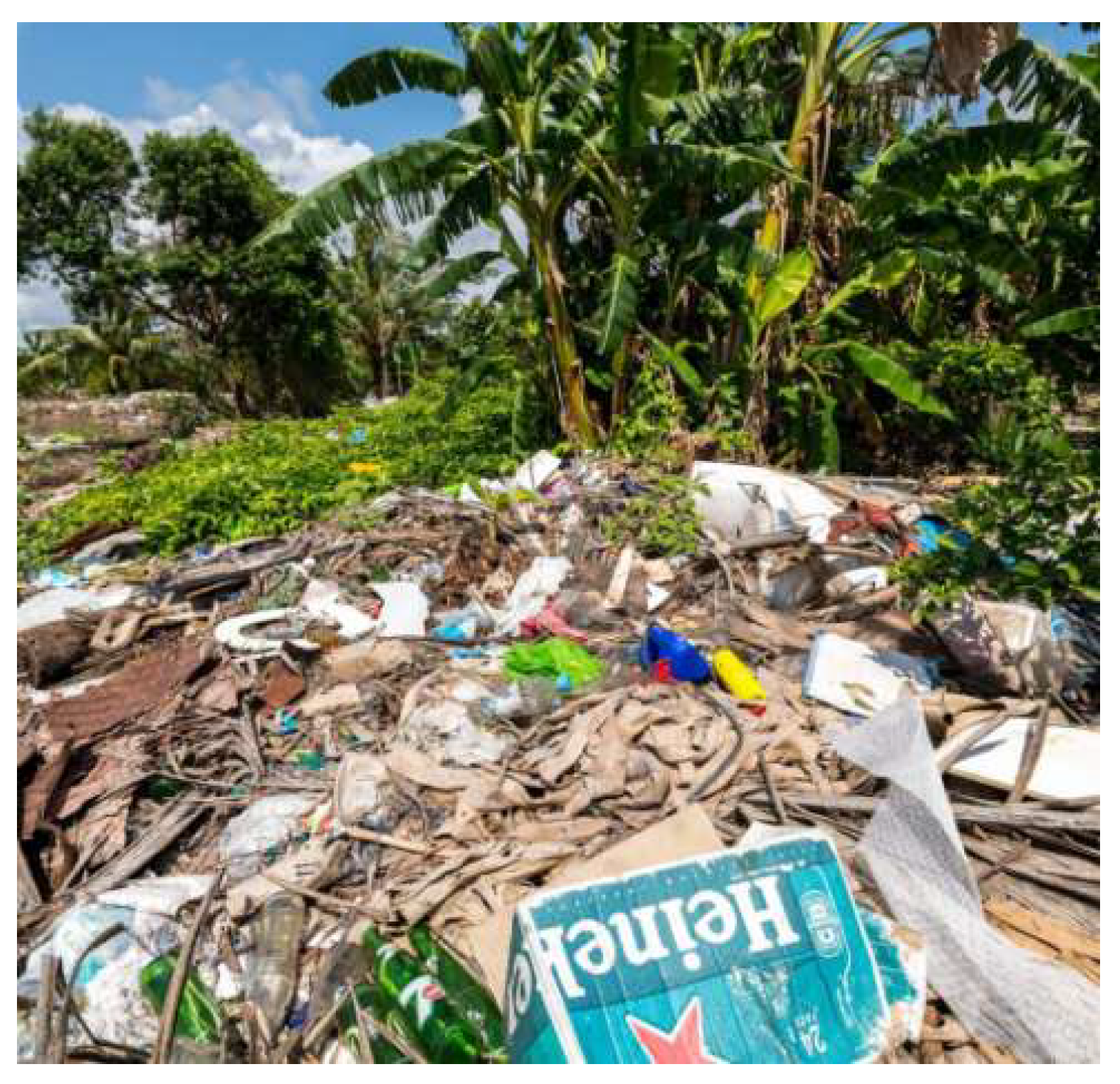
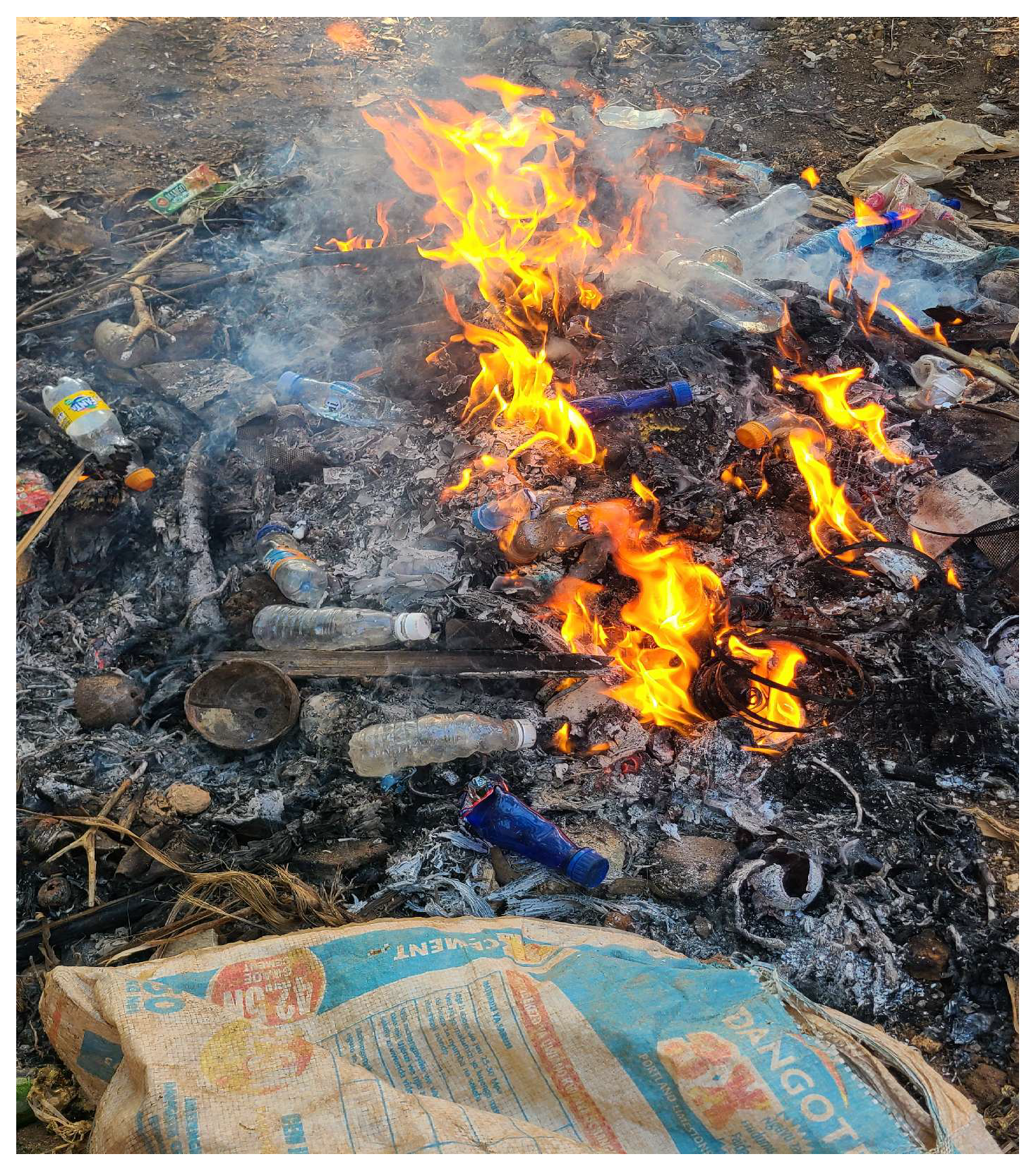
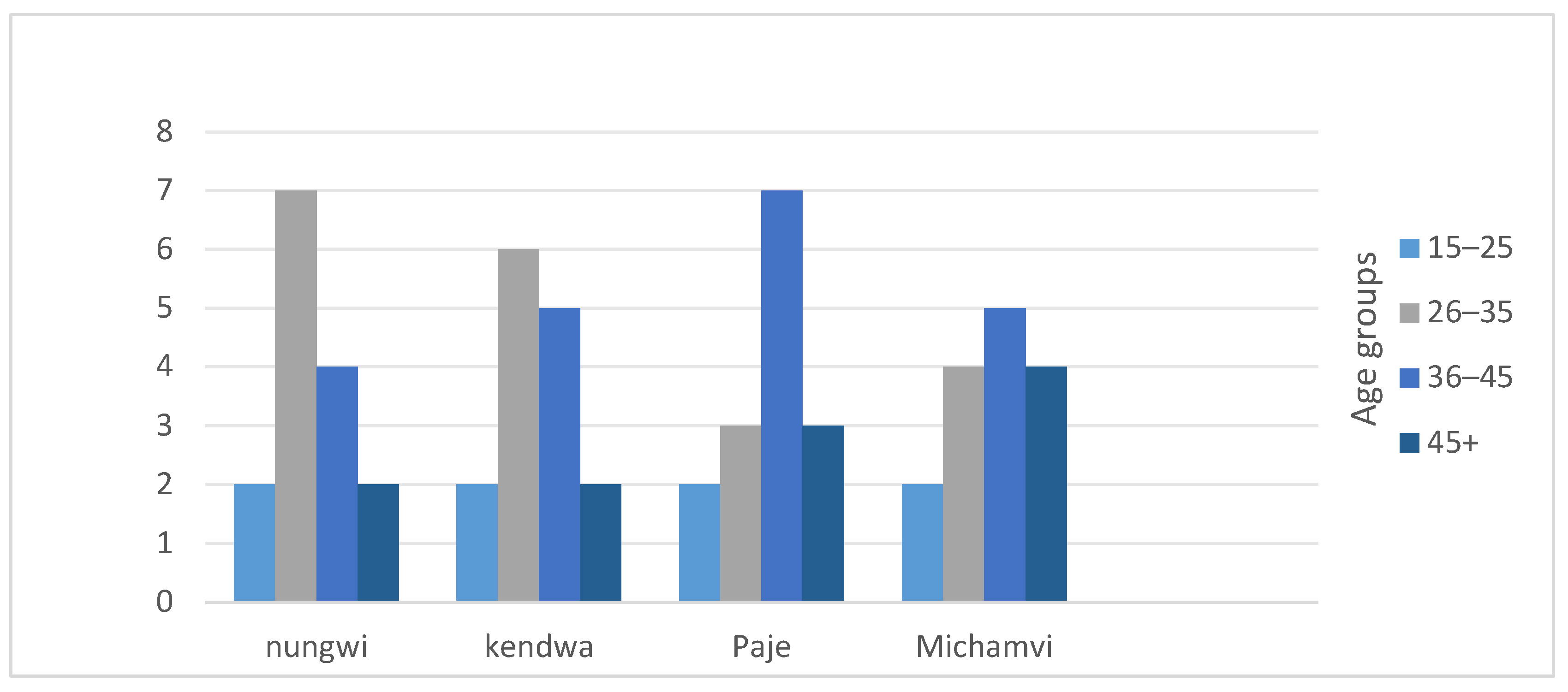
| Theme | Example Questions | Purpose |
|---|---|---|
| Demographic profile | Age group; location | To contextualize responses |
| Perceptions of hotel waste | Do you think hotel waste is a problem in your community? Do you benefit from hotel waste in any way? | To capture positive and negative perceptions |
| Environmental & health impacts | What effects of hotel waste do you observe (e.g., roadside dumping, children scavenging, marine pollution)? | To identify lived experiences of environmental and health impacts |
| Community roles in waste management | How can your community help reduce hotel food waste? What about plastic waste? | To explore community-based solutions |
| Gender and youth involvement | In what ways should women and youth be more involved in plastic waste management? | To address inclusivity and social dimensions |
| Policy awareness | Have you heard of government policies such as the Zanzibar Declaration for Sustainable Tourism? How effective are they? | To assess policy knowledge and perceived effectiveness |
| Community–tourism partnerships | What kinds of partnerships between communities and hotels would improve plastic waste management? | To explore opportunities for co-management. |
| Focus Area | Guiding Questions | Purpose |
|---|---|---|
| Waste generation patterns | What types of plastic waste are most common in hotels and communities? How are they currently managed? | To identify dominant waste streams and current practices |
| Roles of stakeholders | What roles do hotels, communities, waste contractors, and recycling firms play in waste management? | To clarify stakeholder responsibilities and interactions |
| Challenges in waste management | What are the main obstacles (e.g., infrastructure, awareness, costs, enforcement)? | To capture systemic barriers |
| Community–tourism collaboration | How can hotels and communities work together to reduce plastic waste? | To explore partnership and co-management opportunities |
| Gender and youth participation | How can women and youth be better engaged in waste reduction and recycling initiatives? | To address inclusivity and social innovation |
| Policy and governance | How effective are existing regulations (e.g., bans, the Zanzibar Declaration for Sustainable Tourism)? | To assess governance effectiveness and enforcement gaps |
| Proposed solutions | What practical measures can be introduced at community and hotel levels to improve outcomes? | To co-develop actionable interventions |
| Village | Observed Activity Level | Observation Notes |
|---|---|---|
| Nungwi | Most active | High volume of tourism-generated waste; consistent presence of NGO-led programs and district council-supported initiatives |
| Kendwa | Highly active | Active swap shops observed; visible hotel-community collaboration and youth engagement in awareness activities |
| Paje | Moderately active | Community-led clean-up events and school-based activities noted; some support from swap shops present. |
| Michamvi | Least active | No visible recycling infrastructure or swap shop activities; absence of organized collection systems and incentive structures. |
Disclaimer/Publisher’s Note: The statements, opinions and data contained in all publications are solely those of the individual author(s) and contributor(s) and not of MDPI and/or the editor(s). MDPI and/or the editor(s) disclaim responsibility for any injury to people or property resulting from any ideas, methods, instructions or products referred to in the content. |
© 2025 by the authors. Licensee MDPI, Basel, Switzerland. This article is an open access article distributed under the terms and conditions of the Creative Commons Attribution (CC BY) license (https://creativecommons.org/licenses/by/4.0/).
Share and Cite
Abdulkadir, A.; Ally, B.; Remmen, A.; Hirsbak, S.; Salukele, F. Plastic Waste Management Practices in Zanzibar’s Coastal Tourist Communities. Sustainability 2025, 17, 9692. https://doi.org/10.3390/su17219692
Abdulkadir A, Ally B, Remmen A, Hirsbak S, Salukele F. Plastic Waste Management Practices in Zanzibar’s Coastal Tourist Communities. Sustainability. 2025; 17(21):9692. https://doi.org/10.3390/su17219692
Chicago/Turabian StyleAbdulkadir, Aziza, Biubwa Ally, Arne Remmen, Stig Hirsbak, and Fredrick Salukele. 2025. "Plastic Waste Management Practices in Zanzibar’s Coastal Tourist Communities" Sustainability 17, no. 21: 9692. https://doi.org/10.3390/su17219692
APA StyleAbdulkadir, A., Ally, B., Remmen, A., Hirsbak, S., & Salukele, F. (2025). Plastic Waste Management Practices in Zanzibar’s Coastal Tourist Communities. Sustainability, 17(21), 9692. https://doi.org/10.3390/su17219692







